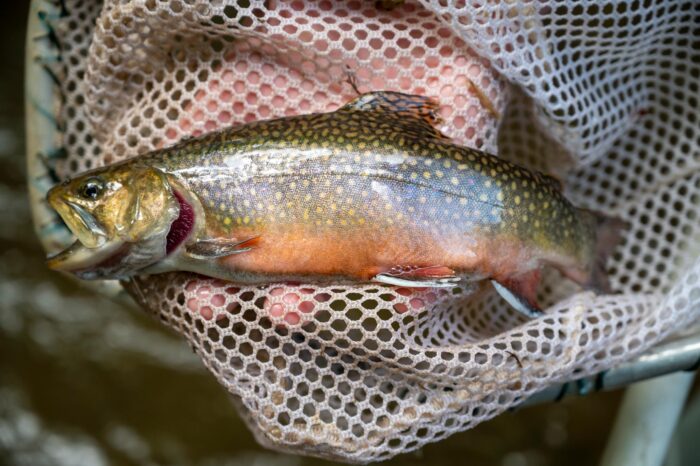Catch native and stocked trout with these helpful tips from the WVDNR.
When it comes to fishing, it doesn’t get much better than casting a line into a West Virginia trout stream on a chilly morning. Whether you’re a seasoned angler or a novice looking to hook your first catch, here are a few tips to help you catch stocked and native trout species. So, grab your fishing rod, get your fishing license and trout stamp and wade out for a fishing adventure!
Rainbow Trout
If you want to hook a rainbow trout, try synthetic moldable bait and salmon eggs in a variety of colors, especially if you’re casting a line into a water stocked with hatchery fish. In the fall, use minnow-imitating small crankbaits, which are effective when cast into the current near a river or stream inlets. Other popular lures include small spinners and jigs, which will work year round. If it’s wintertime, try live worms or minnows, if not restricted. The easiest way to find out if minnows are prohibited in the water you want to fish in is to search our online fishing map at mapwv.gov/huntfish.
Golden Rainbow Trout
West Virginia’s golden rainbow trout is a prized catch and for good reason! Here are just a few helpful tips to help you hook one of your own. Target golden rainbows early in the day when they are more likely to bite or late in the evening. These fish also become bait-shy pretty quick, especially in areas that get a lot of pressure. If that happens to you, try different baits and lures these fish are not seeing every day, such as corn, synthetic baits that are purchased in little jars and even marshmallows. Also, it pays to wear dark clothing or camouflage, which is less visible to the fish.
Brown Trout
If you’re looking to catch a brown trout, here’s a little advice: When fishing in rivers, try to fish behind boulders and other structures. Brown trout hide behind these structures in faster water to pounce on prey that swims or floats by. In a slower current, they spread out more when feeding. Another thing to keep in mind when picking bait is that brown trout are big predators and love to eat minnows or other live baits. If using artificial baits, something that imitates a minnow is never a bad choice.
Tiger Trout
Tiger trout live up to their name! If you want to catch one, don’t go after them the same way you would species that are known to be more mellow. Give them something to chase by using large, animated flies. Another thing to keep in mind is that you need to be stealthy when targeting big tigers. This means approaching quietly from the correct side and casting discreetly and efficiently (especially on stillwater). If you’re a live bait angler, minnows or nightcrawlers are a top pick, just be sure to check if they are allowed in the water you want to fish in by searching our online fishing map at mapwv.gov/huntfish.
Brook Trout
Need some help catching brook trout? In lake environments, brook trout are normally caught in sheltered areas or along submerged boulders and fallen trees. Try casting toward shore or along the shore followed by slow and partial retrieval of the bait, allowing it to slowly sink before you reel it in. Brook trout are extremely opportunistic feeders. If you’re fishing with a spin rod, small spinners are ideal. If you’re using a fly rod, keep it basic with fluffy attractor patterns like Stimulators and Elk Hair Caddis on top and nymphs like Copper Johns and Prince Nymphs underneath.
Native brook trout are found in many small tributaries in West Virginia’s more mountainous counties. Anglers pursue them either by flyfishing or by using live bait, such as worms and mealworms. Depending on where you’re fishing, live bait may not be allowed, so check the West Virginia Fishing Regulations Summary before you cast a line.
Get Your West Virginia Fishing License and Plan Your Next Adventure!
Ready to experience the joy of fishing in Almost Heaven, West Virginia? The first step is to purchase your fishing license and trout stamp. It’s quick and easy. Just visit WVfish.com, a license retailer or a WVDNR District Office near you. Buy your license and stamps today!

